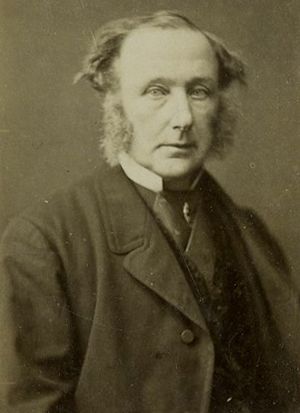Thomas Douglas Forsyth facts for kids
Quick facts for kids
Thomas Douglas Forsyth
|
|
|---|---|

Photo of Forsyth, circa 1870
|
|
| Born | 7 October 1827 |
| Died | 17 December 1886 (aged 59) |
| Occupation | Diplomat |
Sir Thomas Douglas Forsyth (born October 7, 1827 – died December 17, 1886) was an important British official and diplomat. He worked in India during the time it was ruled by the British. He was known for his efforts to improve trade and relations with countries in Central Asia.
Contents
Early Life and Education
Thomas Douglas Forsyth was born in Birkenhead, England, on October 7, 1827. He was one of many children in his family. He went to school at Sherborne School and Rugby. Later, he studied at the East India Company's college in Haileybury. This college trained people to work for the British in India. He finished his studies there in December 1847.
Working in India
First Jobs and Challenges
Forsyth arrived in Calcutta, India, in March 1848. He quickly learned important local languages like Persian, Hindustani, and Hindi. Soon after, he was given a job in Saharanpur.
In 1849, after the Punjab region became part of British India, Forsyth helped manage the new area. He worked in places like Pakpattan and Shimla. In 1850, he got married to Alice Mary.
He later worked in Kangra. In 1854, he became very ill and had to return to England for a while. When he came back to India, he worked in Gurdaspur and Rawalpindi. Then, he moved to Umballa in 1855.
Role in the 1857 Rebellion
Forsyth was in Umballa when the Indian Rebellion of 1857 began. He was one of the first to notice the signs of trouble and reported them. After the city of Delhi was captured, he helped investigate the rebellion. He looked through important papers, including those of the Nana of Cawnpore.
He arrived in Lucknow as the rebels were leaving the city. For his work during this time, he received an award called the Order of Companion of the Bath.
Improving Trade and Relations
In 1867, Forsyth traveled to Leh, the capital of Ladakh. His goal was to remove rules that made trade difficult between Xinjiang and Punjab. When he returned, he started a yearly fair in Palampur. Traders from Xinjiang were invited to this fair.
His experiences made him want to improve relations between the British government in India, Central Asia, and Russia. He was allowed to go to St. Petersburg, Russia. His mission was to agree with the Russian government on the borders of the Amir of Kabul's land. He successfully showed that certain areas belonged to the Amir, and Russia agreed.
Journey to Yarkand
Forsyth returned to India in 1869. At this time, a leader named Yakub Beg from Yarkand and Kashgar wanted to connect with India. He sent a message asking for a British officer to visit him. Forsyth was chosen to go with the envoy. His job was to gather information about the people and the land, not to make political deals.
The journey from Lahore to Yarkand and back was 2,000 miles long. It took six months. Part of the trip involved crossing high mountains, about 16,000 feet above sea level. Forsyth described how hard it was, saying that even resting, it was difficult to breathe. He also felt very tired and sick.
Later Missions
In 1872, a group called the Namdhari (Kuka) sect caused trouble in Malerkotla. Forsyth was put in charge of stopping the uprising. There was some confusion about his powers. Another official had already executed many rebels before Forsyth arrived. Forsyth felt he had to support this action.
An investigation followed, and both Forsyth and the other official were removed from their jobs. Forsyth appealed this decision. As a result, in 1873, he was appointed to a new important mission to Kashgar. The goal was to make a trade agreement with the Amir. This mission helped remove barriers to trade between the two regions. For his success, Forsyth received the award of Knight Commander of the Star of India.
In 1875, Forsyth was sent to the King of Burma. He helped settle a disagreement about the Karenni States. An agreement was reached that these states would be recognized as independent.
Later Life and Legacy
Forsyth left India in 1876 and officially retired in 1877. In his later years, he worked with Indian railway companies. He helped start a company in 1879 to connect Marmagao with other parts of India. In 1883, he visited India again to check on the railway work.
Sir Thomas Douglas Forsyth passed away on December 17, 1886, in Eastbourne, England.
He is remembered in the name of a Chinese lizard species, Phrynocephalus forsythii.
Works
- Yarkand (Forsyth's mission) (1871)
- Report of a Mission to Yarkund in 1873, Under Command of Sir T. D. Forsyth ... (1875)
- Report of a Mission to Yarkund in 1873 : vol.1
- Autobiography and Reminiscences of Sir Douglas Forsyth, C.B., K.C.S.I., F.R.G.S. Edited by his daughter. Publisher: R. Bentley and Son, London, 1887
Sources
- Forsyth, Sir Thomas Douglas (1887) (in en). Autobiography and Reminiscences of Sir Douglas Forsyth, C.B., K.C.S.I., F.R.G.S.. London: Richard Bentley and Son. https://books.google.com/books?id=uE9g1Hcb5GcC.
 This article incorporates text from a publication now in the public domain: "Forsyth, Thomas Douglas". Dictionary of National Biography. (1885–1900). London: Smith, Elder & Co.
This article incorporates text from a publication now in the public domain: "Forsyth, Thomas Douglas". Dictionary of National Biography. (1885–1900). London: Smith, Elder & Co. - Forsyth, W. (1887). "Obituary: Sir T. Douglas Forsyth, K. C. S. I., C. B.". Proceedings of the Royal Geographical Society 9 (2): 123–126. ISSN 0266-626X.

